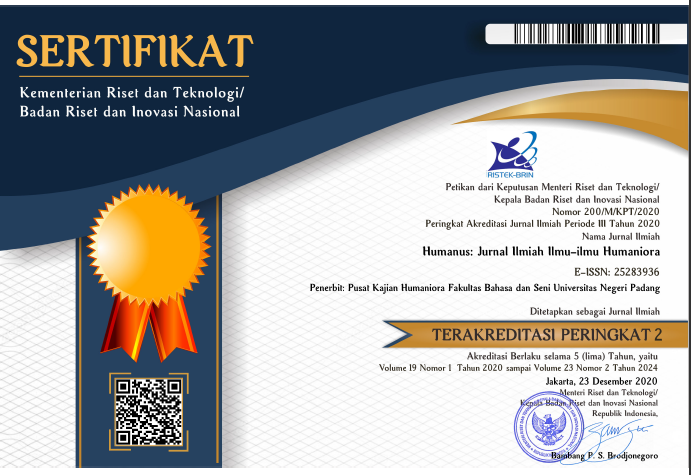MADURESE PROVERBS USING COLOR NAME ELEMENT: AN ETHNOLINGUISTIC STUDY
 ), Wakit Abdullah Rais(2), Dwi Purnanto(3),
), Wakit Abdullah Rais(2), Dwi Purnanto(3), (1) Universitas Sebelas Maret
(2) Universitas Sebelas Maret
(3) Universitas Sebelas Maret
 Corresponding Author
Corresponding Author
Copyright (c) 2019 Humanus
DOI : https://doi.org/10.24036/humanus.v18i2.107167
Full Text:
 Language : id
Language : id
Abstract
Keywords
References
Abdullah, W. (2017). Kearifan lokal dalam bahasa dan budaya Jawa masyarakat nelayan di Pesisir Selatan Kebumen (Sebuah Kajian Etnolinguistik). Surakarta: UNS Press.
Ahimsa-Putra, H. S. (1997). Etnolinguistik: Beberapa bentuk kajian. Temu Ilmiah Bahasa Dan Sastra: 26-27 Maret 2018.
Ahmad, R. M. (2007). Manusia Madura. Yogyakarta: Pilar Media.
Bastari, & Fiandarti, Y. I. (2009). Kosa kata bahasa Madura lengkap. Surabaya: Karya Simpati Mandiri.
De Jonge, H. (2011). Garam kekerasan dan aduan sapi. Yogyakarta: LKiS Printing Cemerlang.
Kurnia, D. E. (2016). Metafora binatang dalam peribahasa Jawa. Prasasti III, 283–287.
Kingkin P., K., & Rachman, K. A. (2019). Metafora Tumbuhan dalam Peribahasa Indonesia (Kajian Semantik Kognitif). Jurnal Belajar Bahasa, 4(1), 68–81.
Kusumawati, S. (2016). Leksikon budaya dalam ungkapan peribahasa Sunda (Kajian antropolinguistik). Jurnal Lokabasa, 7(1), 87–93.
Nugraha, A. P. (2017). Makna peribahasa Madura dan stereotip kekerasan pada etnis Madura (Tinjauan Stilistika). LiNGUA: Jurnal Ilmu Bahasa Dan Sastra, 12(2), 90. https://doi.org/10.18860/ling.v12i2.4172
Spradley, J. (2007). Metode etnografi. Yogyakarta: Tiara Wacana.
Subroto, E. (2011). Pengantar studi semantik dan pragmatik. Surakarta: Cakrawala Media.
Sunarni, N., & Johana, J. (2019). Makna budaya leksikon “Mizu” yang tercermin dalam peribahasa Jepang dan padanannya dalam peribahasa Sunda. Journal of Japanese Language Education and Linguistics, 3(1), 14–34. https://doi.org/10.18196/jjlel.3122
Yunyu, X. (2015). Warna dalam bahasa Mandarin dan bahasa Indonesia: Sebuah kajian linguistik antropologis. Disertasi, Universitas Gadjah Mada.
 Article Metrics
Article Metrics
 Abstract Views : 392 times
Abstract Views : 392 times
 PDF Downloaded : 166 times
PDF Downloaded : 166 times
Refbacks
- There are currently no refbacks.
Copyright (c) 2019 Humanus

This work is licensed under a Creative Commons Attribution-NonCommercial 4.0 International License.










